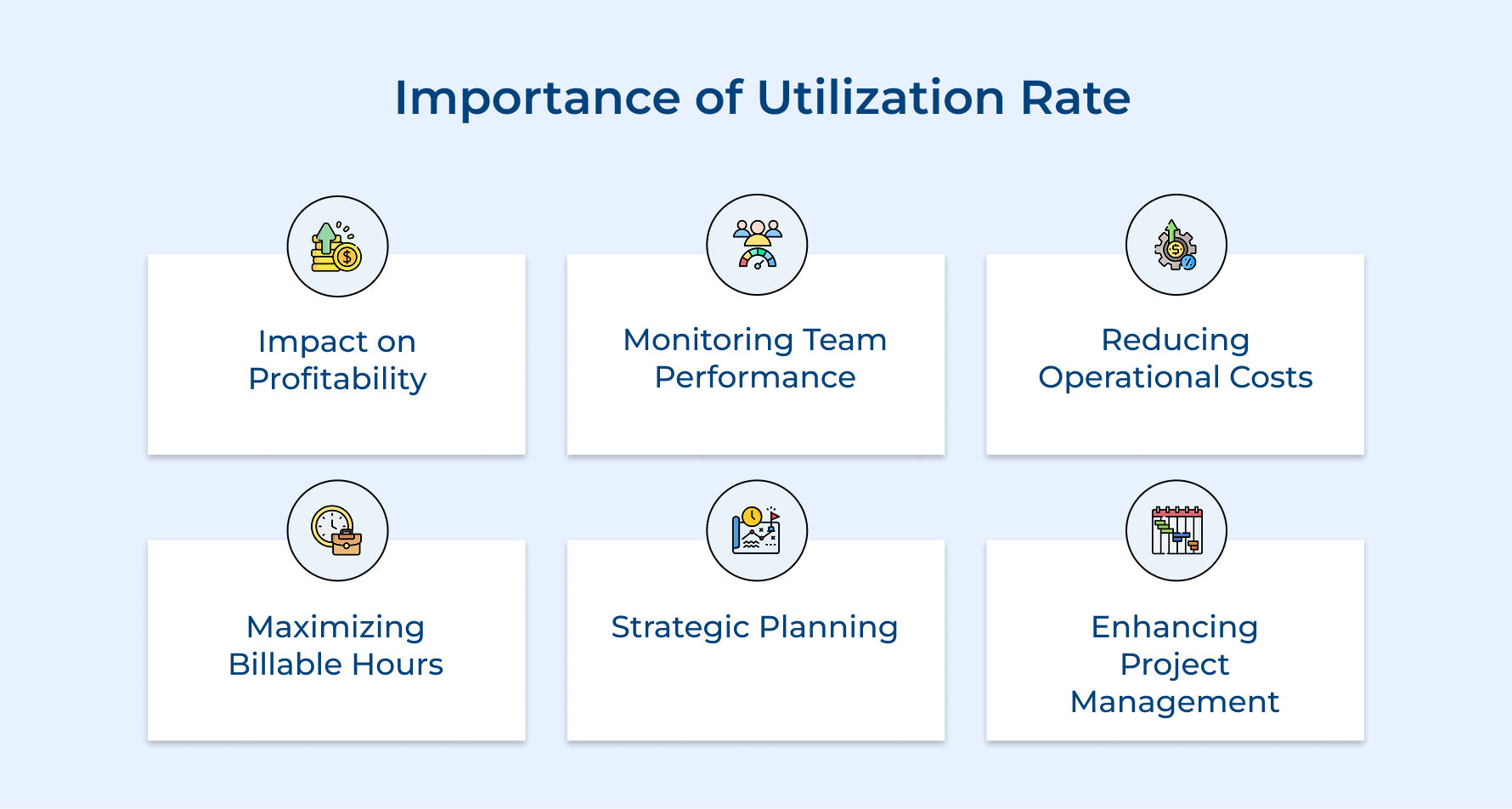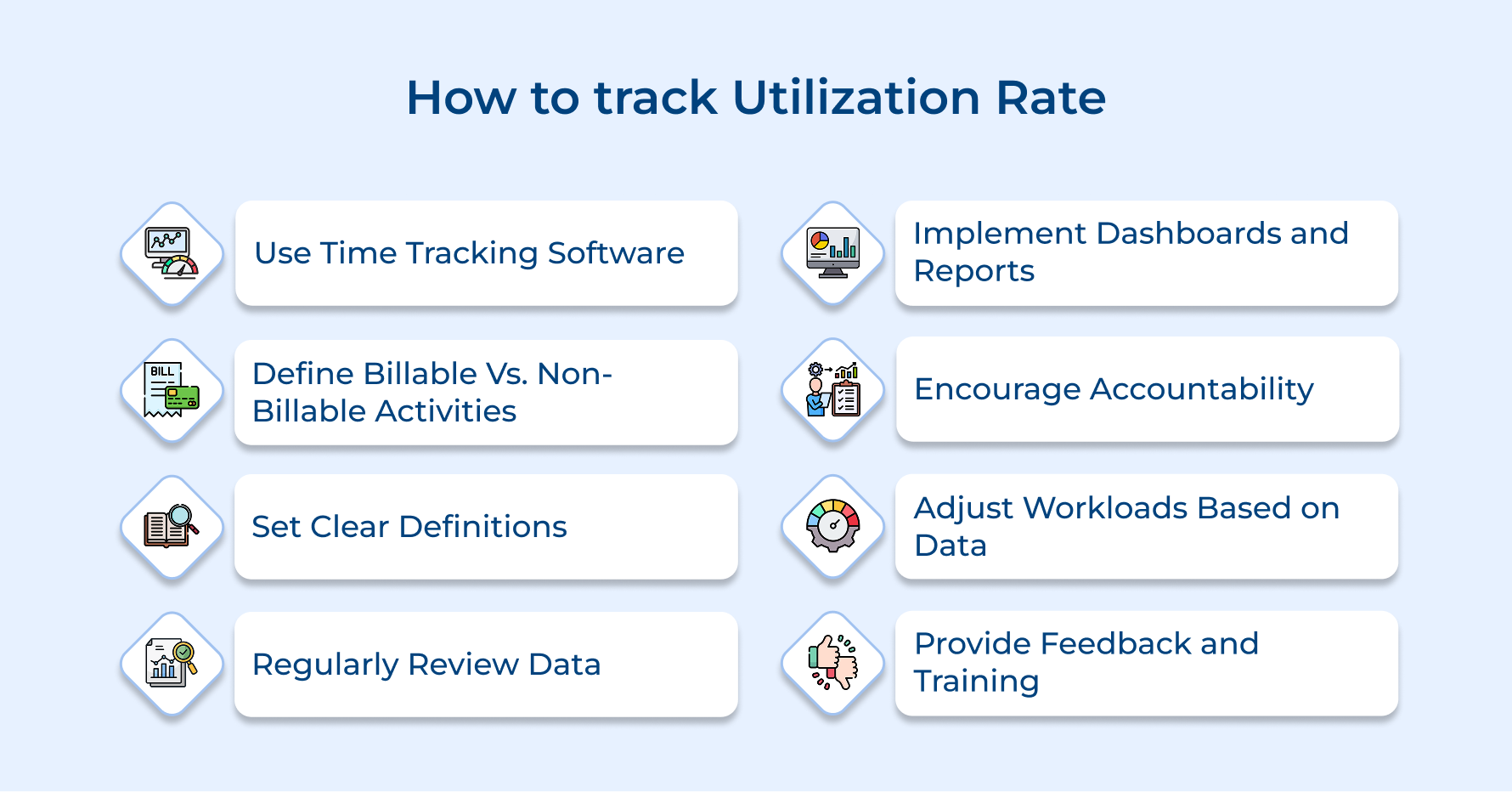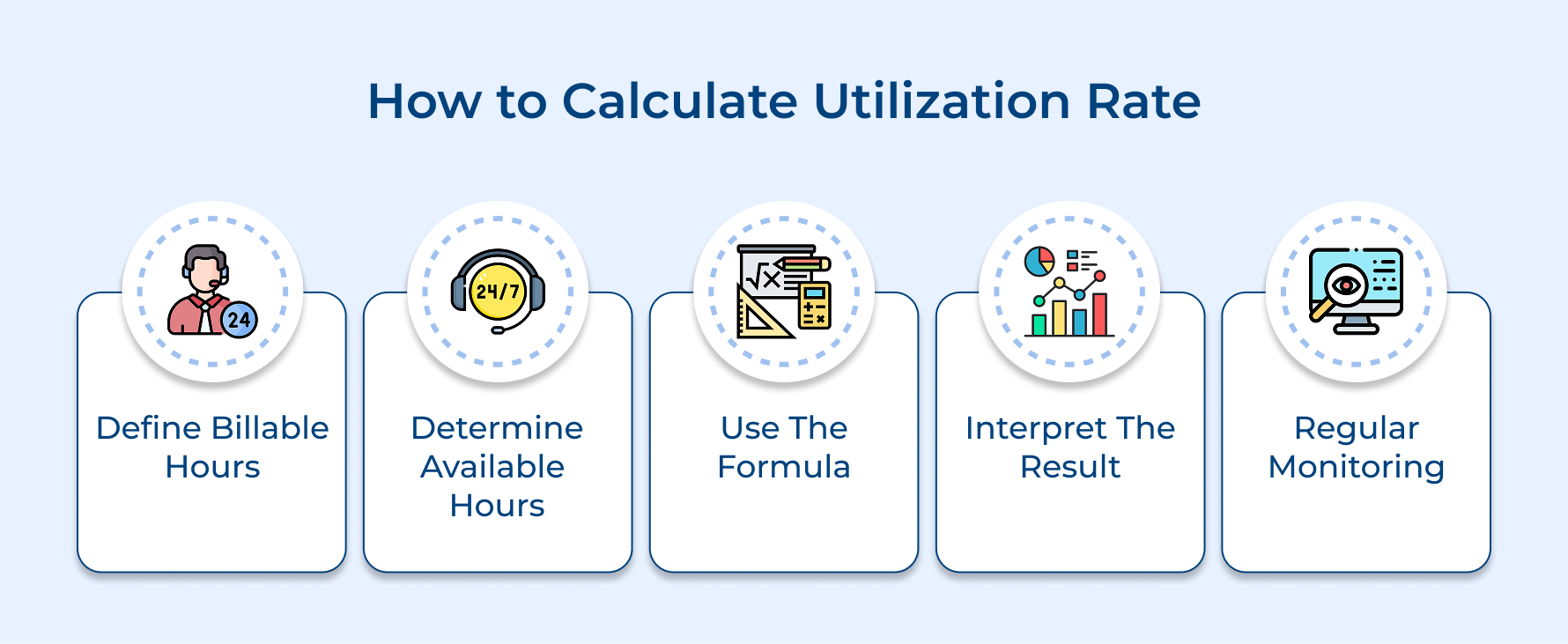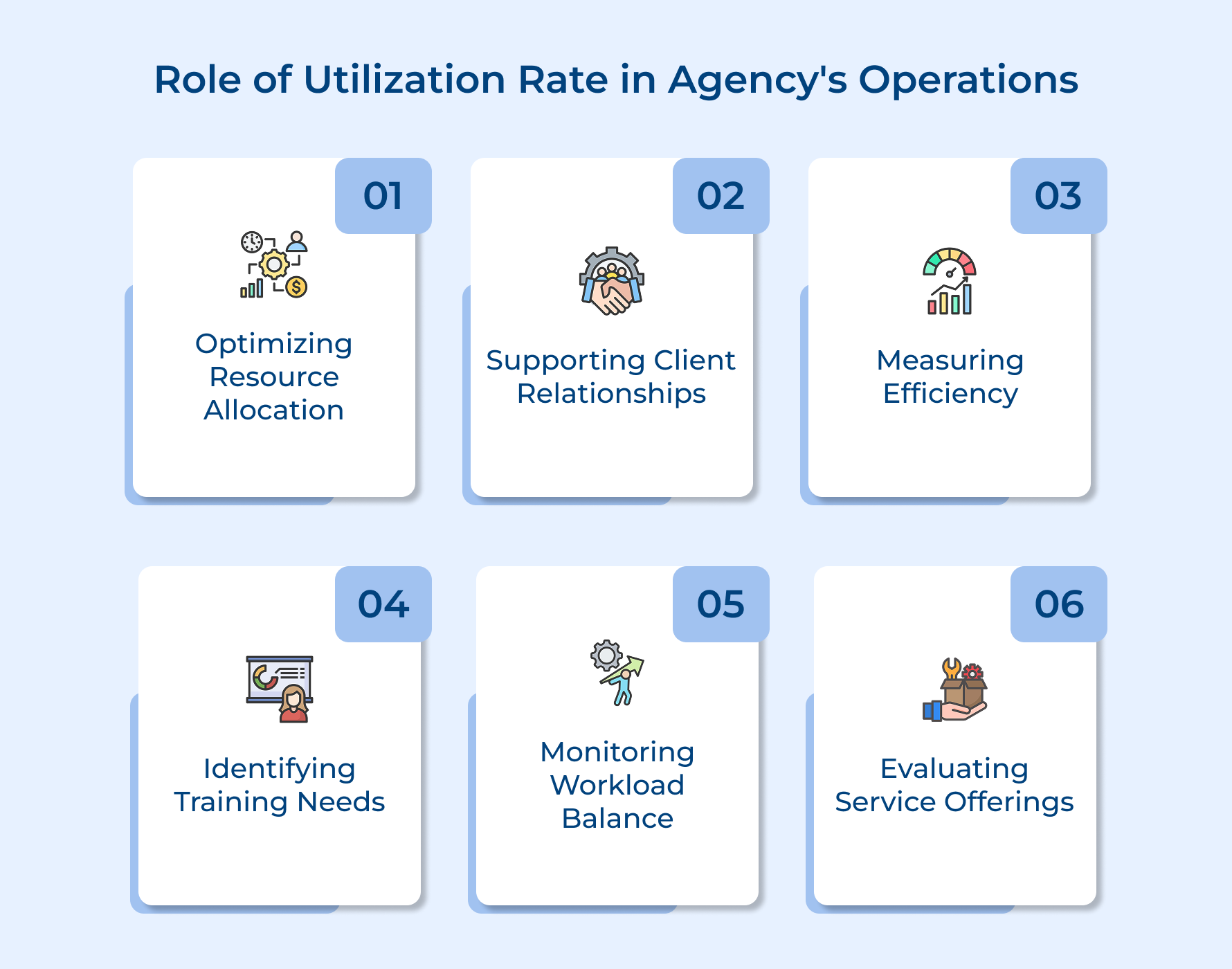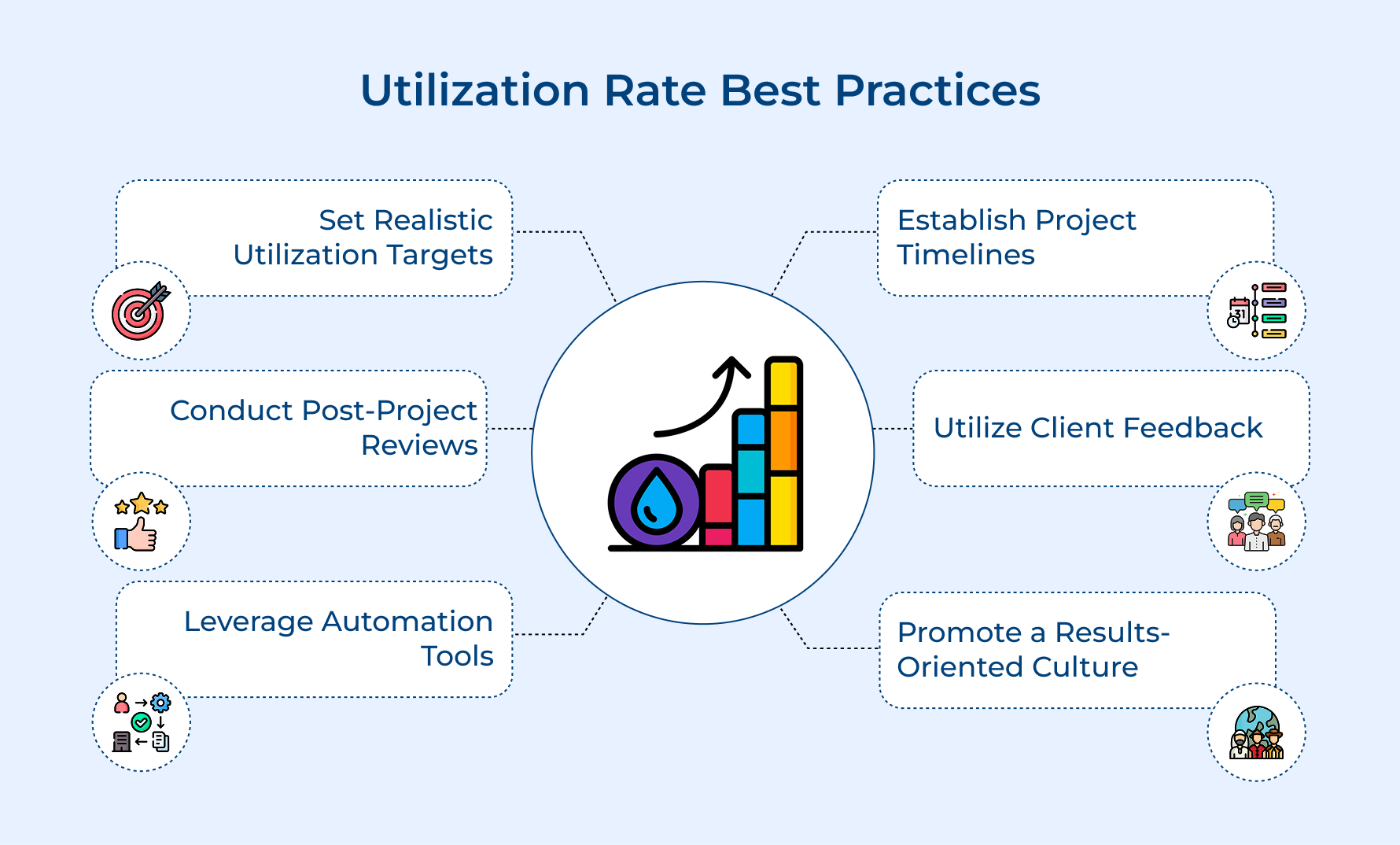Utilization Rate Guide: Definition, Calculation & Benefits
- What is Utilization Rate?
- Why Utilization Rate Matters?
- How to Track the Utilization Rate in Operations Management
- How to Calculate The Utilization Rate?
- The Role of Utilization Rate in Your Agency’s Operations
- Best Practices to Improve Utilization Rate
- Factors Affecting Utilization Rate In Every Agency
- Maximizing Profitability Through Effective Utilization
- FAQs about Utilization Rate Metric
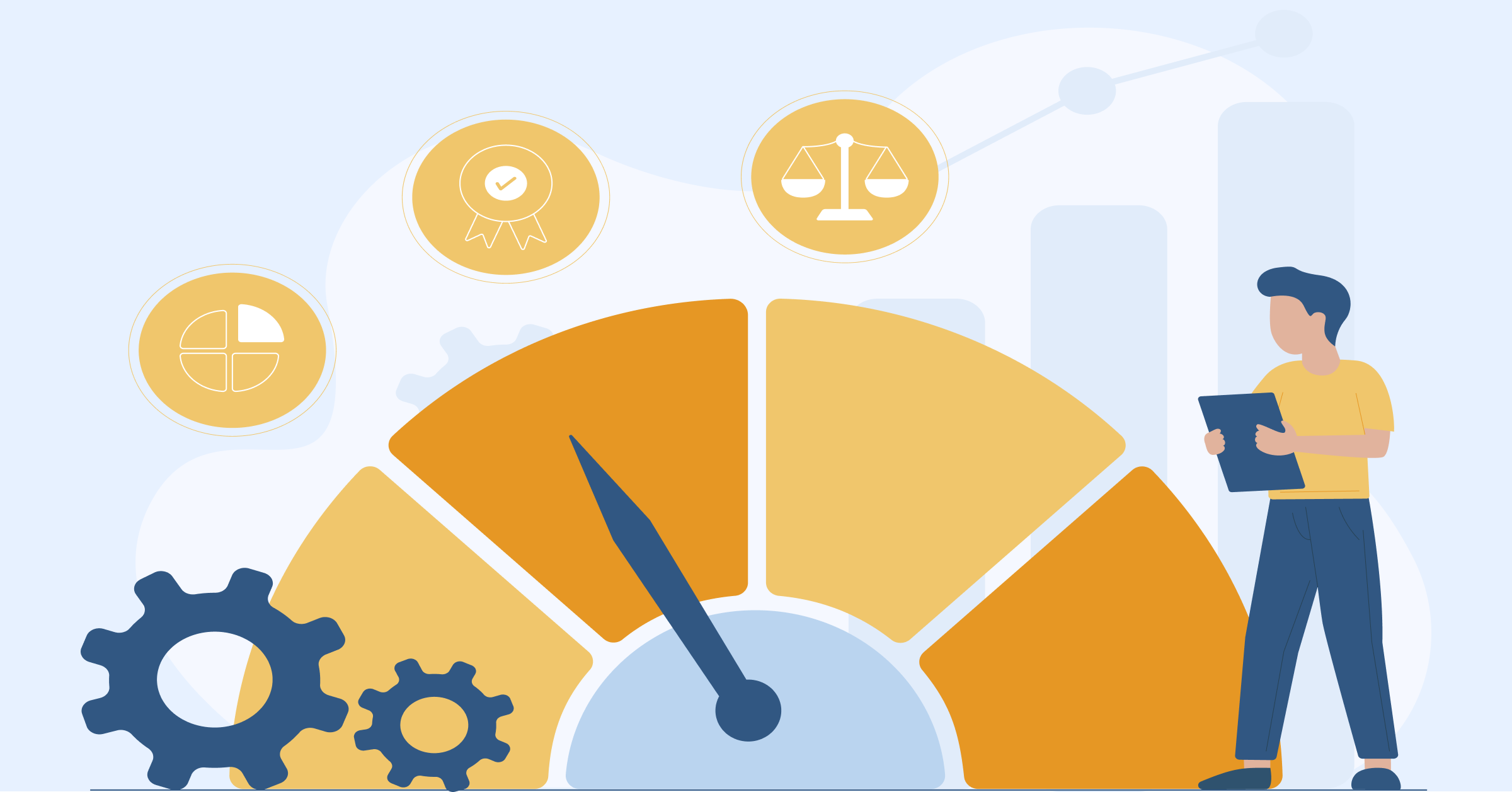
Key Highlights
How many hours was your team available for the project? And how much productivity did the time spent actually produce? Calculating these aspects might seem like a daunting task, but it is one of the most significant aspects of running an agency or professional services firm.
There must be a clear distinction between billable and total hours to avoid miscommunication or burnout. According to Mercer’s report, 37% of employees cite excessive workload as the reason for burnout. As an employee gets overworked, the probability of disengagement or lower service quality increases.
Understanding utilization rates is essential for optimizing productivity and encouraging a positive work environment. Let’s explore their importance and how to manage them effectively.
What is Utilization Rate?
The utilization rate is a key performance metric that measures the efficiency of an agency’s workforce. It measures the percentage of an employee’s available working hours that are spent on billable or productive tasks. A higher rate signifies that more hours are being spent on billable work, which is crucial for maintaining profitability.
As agencies strive to improve operations and increase profitability. So, this knowledge helps allocate resources more effectively and boosts overall productivity, which is key to staying competitive.
Key objectives:
- Optimize resource allocation: Ensuring that the right people are assigned to the right projects for maximum efficiency.
- Enhance profitability: Identifying billable versus non-billable hours helps agencies focus on revenue-generating activities.
- Improve employee productivity: Monitoring utilization encourages a culture of accountability and encourages employees to manage their time effectively.
Why Utilization Rate Matters?
Utilization rate is more than just overhead costs or the number of hours per week spent by the employees. Let’s explore the key aspects of why it matters.
- Financial impact on profitability: Utilization rate directly correlates with profitability. Higher rates indicate more billable hours, leading to increased revenue. Improved profitability allows for reinvestment in the business and better compensation for employees, encouraging overall growth.
- Monitoring team performance: Tracking utilization rates provide insights into individual and team productivity. Managers can identify high performers, spot inefficiencies, and address underperformance. Regular monitoring enables timely interventions and maintains consistent output quality across the organization.
- Reducing operational costs: Optimal utilization rates minimize idle time and resource wastage. Efficient resource allocation reduces the need for unnecessary overtime or additional hiring. Companies can streamline operations, cut down on overhead expenses, and maximize the value derived from existing resources.
- Maximizing billable hours: High utilization rates reflect effective time management and task prioritization. Teams focusing on billable work generate more revenue per employee. Maximizing billable hours ensures valuable skills and resources are directed toward profit-generating activities.
- Strategic planning: Resource utilization rate informs strategic decisions about capacity planning, hiring needs, and service offerings. Accurate data helps predict future resource requirements, identify skill gaps, and align workforce capabilities with market demands that secure future projects from the same client.
- Enhancing project management: Utilization rates guide project scheduling and resource allocation. Project managers can balance workloads and ensure timely project completion. Improved project management leads to higher client satisfaction and a stronger reputation in the industry.
How to Track the Utilization Rate in Operations Management
A consistent monitoring of time spent on billable vs non-billable work gives you an understanding of what the utilization rate is. Here’s how you find the best methods to track:
1. Use Time Tracking Software
Time tracking software is essential for accurate and efficient utilization rate calculation. Manual tracking is prone to errors and time-consuming. The software automates the process, providing real-time data on billable and non-billable hours.
Implement time-tracking software that integrates with your project management tools. Employees can log their hours against specific projects or tasks. The software can automatically categorize time as billable or non-billable work based on predefined rules. Generate reports to calculate utilization rates for individuals, teams, or the entire organization.
Actionable tips:
- Choose user-friendly software with mobile apps to encourage consistent use by all employees.
- Integrate the time tracking software with your invoicing system to streamline billing processes.
2. Define Billable vs. Non-Billable Activities
Clearly define billable and non-billable tasks for accurate utilization rate calculations. Without these definitions, employees may inconsistently categorize their time, leading to skewed data.
Create a comprehensive list of activities, categorizing each as billable or non-billable. Use this list to set up categories in your time-tracking software. Regularly review these definitions as your business evolves. Well-defined categories ensure that all team members are on the same page, resulting in reliable utilization rate metrics.
Tips:
- Involve team leaders from different departments to create a comprehensive and relevant list of activities.
- Create a quick reference guide for employees to easily determine how to categorize their time.
3. Set Clear Definitions
Transparent definitions usually include working hours, overtime, and how to handle different types of leave. Uneven understanding can cause discrepancies in how utilization rates are calculated across the organization.
Develop a comprehensive guide that outlines all definitions related to utilization rate tracking. Use this guide to configure your time-tracking software and to train employees. Use the definitions to ensure consistent reporting and analysis.
Pro tips:
- Create a glossary of terms related to utilization rate and make it easily accessible to all employees.
- Hold regular training sessions to ensure all team members understand and apply the definitions consistently.
4. Regularly Review Data
Consistent data review helps catch discrepancies or errors in time tracking, ensures the system is being used correctly, and provides insights into team performance. A regular review allows for timely adjustments to workloads or processes.
Set up a schedule for data review, such as weekly or bi-weekly. Analyze individual, team, and company-wide utilization rates. Look for patterns or anomalies in the data and leverage it to make informed decisions. It can be about resource allocation, pricing strategies, and operational improvements.
Pro tips:
- Assign a team member to be responsible for regular data review and reporting.
- Create a checklist of key metrics and patterns to look for during each review session.
5. Implement Dashboards and Reports
Dashboards as well as reports provide visual representations of utilization rate data, making it easier to understand and act upon. They offer real-time insights into performance, helping managers make informed decisions quickly. Dashboards also increase transparency across the organization and motivate employees by showing their contribution to overall productivity.
Design dashboards that display key utilization metrics for individuals, teams, and the company. Set up automated reports to be sent to relevant stakeholders regularly. Leverage these visuals in team meetings to discuss performance and set goals.
Actionable tips:
- Customize dashboards for different roles, showing relevant metrics for each user group.
- Include drill-down capabilities in dashboards to allow for deeper analysis when needed.
6. Encourage Accountability
Accountability ensures that all team members take responsibility. It promotes a culture of efficiency, where employees are mindful of how they spend their time. Accountability also helps in addressing issues that may be affecting individual or team performance.
Implement a system where employees regularly review their utilization rates. Set individual and team targets for utilization. Discuss these in performance reviews and team meetings. Recognize and reward high performers while also providing guidance to those struggling to meet targets. Encourage open communication about challenges affecting utilization.
Tips:
- Implement a peer review system where team members can share and discuss their utilization rates.
- Create a recognition program that acknowledges consistently high utilization rates.
7. Adjust Workloads Based on Data
Data-driven workload adjustment ensures optimal resource allocation and prevents burnout or underutilization. It helps maintain a balance between high productivity and employee well-being. Regular adjustments based on the data can improve overall efficiency, employee satisfaction, and project outcomes.
Regularly analyze data to identify team members who are consistently over or under-utilized. Use this information to redistribute tasks, reassign projects, or adjust client commitments. Consider hiring additional staff or reducing commitments if utilization rates are consistently too high. Provide additional training or responsibilities to under-utilized team members.
Pro tips:
- Set up alerts for when individual utilization rates fall outside of a predetermined acceptable range.
- Hold monthly resource planning meetings to proactively adjust workloads based on utilization trends.
8. Provide Feedback and Training
Understanding utilization rates and learning to improve them can only be done through regular feedback as well as training. It ensures that team members have the skills and knowledge to work efficiently. Ongoing training can address any gaps in productivity, while feedback helps align individual performance with organizational goals.
Schedule regular one-on-one meetings to discuss individual efforts. Provide constructive feedback on areas for improvement. Offer training sessions on time management, productivity tools, or specific skills that could boost efficiency. Use the data to identify common challenges and develop targeted training programs to address them.
Tips:
- Implement a mentoring program where high performers can share their strategies for maintaining good utilization rates.
- Create a library of resources (videos, articles, tools) that employees can access for self-paced learning to improve productivity.
How to Calculate The Utilization Rate?
Calculating the utilization formula is a straightforward process. Here’s a step-by-step guide:
1. Define Billable Hours
Identify the total number of billable hours worked by employees during a specific period. Billable hours are those spent on tasks that can be charged to clients, such as project work, consulting, or client meetings.
2. Determine Available Hours
Calculating utilization requires the total available hours for the same period. This includes all working hours minus any time off, holidays, or non-working days. Consider the total work schedule, such as a standard 40-hour workweek, and account for any variations in staffing or workload throughout the month.
3. Use the Formula
Apply the following formula to calculate the billable rate:
Using this formula provides a clear picture of how effectively employee time is utilized. Accurate recording of both billable and available hours is essential to maintain precise calculations.
4. Interpret the Result
The result will be a percentage. A higher utilization rate indicates that a larger portion of employee time is spent on billable work, generally correlating with better profitability. For many service-based agencies, a rate above 70% is often considered healthy.
Example of how to calculate utilization,
- Billable Hours: 150
- Available Hours: 200
Using the formula:
{Utilization Rate} = {150/200} * 100 = 75%
In this example, the utilization equation is 75%, meaning that 75% of the available time is spent on billable tasks. This percentage becomes critical when evaluating the efficiency of your agency.
5. Periodic Monitoring
Maintaining an effective utilization rate requires regular monitoring, adjusting workloads, and addressing any areas of inefficiency. Frequent analysis can highlight trends over time and help identify issues before they impact profitability, ensuring sustained business health.
The Role of Utilization Rate in Your Agency’s Operations
Utilization rates play a critical role in agency operations, project management, and overall financial health. Here are the key ways it impacts operations.
1. Optimizing Resource Allocation
Utilization rate serves as a crucial tool for optimizing resource allocation within your agency. Managers identify underutilized talent and redistribute workloads effectively through analysis of these rates.
The process ensures skilled professionals are assigned to appropriate projects, maximizing productivity and preventing resource waste. Optimized allocation leads to improved project outcomes and increased overall efficiency in agency operations.
2. Supporting Client Relationships
Utilization rates play a vital role in maintaining healthy client relationships. High rates indicate clients receive dedicated attention and resources, potentially leading to increased satisfaction.
Consistently low rates might signal the need for more client engagement or project acquisition. Monitoring these rates allows agencies to proactively address client needs, adjust service levels, and maintain a balance between client satisfaction as well as profitability.
3. Measuring Efficiency
You can consider utilization rate as a key performance indicator for measuring an agency’s efficacy. It provides insights into how effectively time and resources are being used across various projects as well as clients. High utilization rates generally indicate streamlined processes and productive teams.
Regular tracking of this metric enables agencies to identify inefficiencies, implement process improvements, and benchmark their performance against industry standards, driving continuous operational enhancement.
4. Identifying Training Needs
Analysis of utilization rates helps in identifying skill gaps and training needs within the agency. Low rates in specific areas or for certain team members may indicate a lack of necessary skills or expertise.
The insight allows agencies to invest in targeted training programs, upskilling initiatives, or strategic hiring to address these gaps. Consequently, the agency can enhance its service quality, expand its capabilities, as well as improve overall utilization rates.
5. Monitoring Workload Balance
Monitoring and maintaining a healthy workload balance across the agency becomes easy with utilization rate analysis. Consistently high rates might signal potential burnout risks, while low rates could indicate underemployment.
Close tracking of these rates enables managers to redistribute tasks, adjust team sizes, or implement work-sharing practices. The balanced approach ensures sustainable productivity, prevents employee burnout, and maintains high-quality output across all projects.
6. Evaluating Service Offerings
Access helpful insights for evaluating and refining an agency’s service offerings from utilization rates. Services with consistently high utilization rates may indicate market demand and profitability, suggesting potential areas for expansion.
Persistently low rates might signal the need to reassess or phase out certain offerings. The data-driven approach helps agencies align their services with market needs, optimize their portfolio, and focus resources on the most profitable as well as in-demand areas.
Best Practices to Improve Utilization Rate
Implementing best practices can significantly enhance utilization rate and profitability within agencies. Here are the most effective strategies.
- Set realistic utilization targets: Establishing realistic utilization targets to motivate employees. Tailoring goals to individual roles and experience levels ensures they are achievable. It encourages a sense of ownership and teams to focus on maximizing billable hours.
- Conduct post-project reviews: Conducting post-project reviews allows agencies to evaluate successes and challenges. Analyzing project performance provides insights that can improve future planning, enhance resource allocation, and lead to higher utilization rates.
- Leverage automation tools: Utilizing automation tools can significantly streamline administrative tasks, freeing up time for billable work. Implementing software for invoicing, reporting, and project management enhances efficiency, allowing teams to focus on delivering high-quality services to clients.
- Establish clear project timelines: Setting clear project timelines helps teams stay organized and focused. Well-defined deadlines create accountability as well as ensure that resources are utilized effectively. It helps increase productivity and higher utilization rates across the agency.
- Utilize client feedback: Understanding client needs as well as satisfaction helps agencies refine processes, deliver better services, and enhance project outcomes. Thus, contributing to increased billable hours and improved utilization rates.
- Promote a results-oriented culture: Encouraging a results-oriented culture encourages employees to prioritize outcomes and performance. Emphasizing the importance of billable work and aligning team efforts with business goals can drive higher utilization rates while enhancing overall agency profitability.
Factors Affecting Utilization Rate In Every Agency
Various factors impact the capacity utilization formula, such as employee skills, client demands and organizational processes, making it vital to address them strategically. Here are the main factors to consider.
Workload Distribution
Uneven workload distribution can significantly impact utilization rates. Overloaded employees may experience burnout and decreased productivity, while underutilized staff represents wasted resources. Balanced allocation ensures optimal utilization across the team, maximizing efficiency and maintaining consistent output quality.
Employee Skills and Expertise
The match between employee skills and project requirements affects utilization. Highly skilled employees may complete tasks faster, potentially lowering their utilization rate. Conversely, less experienced staff might take longer, inflating their rates. Proper skill matching optimizes overall team utilization and project efficiency.
Project Complexity
Complex projects often require more non-billable time for planning, research, and problem-solving, potentially lowering utilization rates. Simpler, routine tasks typically allow for higher utilization. Balancing project portfolios and accurately estimating complexity helps maintain healthy utilization rates across different project types.
Time Management Practices
Effective time management directly influences utilization rates. Poor practices like multitasking or inadequate prioritization can lead to inefficiencies and lower utilization. Implementing robust time-tracking systems and promoting good time-management habits significantly improve overall utilization rates.
Client Demand Fluctuations
Seasonal changes or industry-specific cycles in client demand can cause fluctuations in utilization rates. Periods of high demand may lead to overutilization, while slow periods result in underutilization. Diversifying client base and services stabilize demand as well as maintain consistent utilization.
Technological Infrastructure
The quality and efficiency of an organization’s technological tools impact utilization rates. Outdated or inefficient technology can slow down work processes, reducing billable time. Investing in appropriate, up-to-date technology can streamline operations while also improving overall utilization rates.
Maximizing Profitability Through Effective Utilization
In conclusion, monitoring and managing the utilization rate is crucial for agencies as well as professional services seeking to boost profitability. Understanding this key metric enables businesses to identify inefficiencies that directly impact the bottom line.
A balanced approach to utilization prevents employee burnout and ensures that teams consistently meet client expectations. Executing regular assessments of utilization rates enhances both financial health and service quality, leading to improved client satisfaction. Implementing effective strategies to improve utilization can drive significant gains in profitability and secure long-term success for agencies.
Limit time — not creativity
Everything you need for customer support, marketing & sales.
Neeti Singh is a passionate content writer at Kooper, where he transforms complex concepts into clear, engaging and actionable content. With a keen eye for detail and a love for technology, Tushar Joshi crafts blog posts, guides and articles that help readers navigate the fast-evolving world of software solutions.
